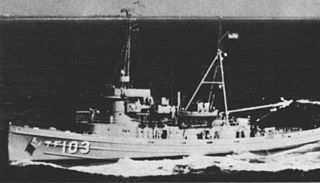
USS Munsee (AT/ATF-107) was an Abnaki-class fleet ocean tug. She is the only ship of the United States Navy to hold the name Munsee, which is the name of a subtribe of the Delaware Indians, still living in Wisconsin and Kansas.
USS Arikara (AT-98) was an Abnaki-class of fleet ocean tug. It was named after the Arikara, a loose confederacy of sub-tribes of American Indians related to the Pawnee. The Arikara inhabited villages in the Missouri River valley.

USS Cree (AT/ATF-84), a Cherokee-class fleet tug, was a ship of the United States Navy named for the Cree, an indigenous people of North America whose people range from the Rocky Mountains to the Atlantic Ocean.

USS Brant (AM-24) was a Lapwing-class minesweeper in the United States Navy during World War II. She was named by the U.S. Navy for the brant, a small goose.
USS Tekesta (AT-93) was Navajo-class fleet tug built during World War II for the United States Navy. Shortly after being built, it was crewed by trained Navy personnel and sent into the Pacific Ocean to provide tug service to damaged ships in battle areas. For successfully performing this dangerous work, she was awarded four battle stars by the war's end.

USS Chickasaw (AT-83/ATF-83) was a Navajo-class fleet tug constructed for the United States Navy during World War II. She served in the Pacific Ocean in World War II and the Korean War, and was awarded six battle stars for World War II and two battle stars during the Korean War.

USS Moreno (AT-87) was a Navajo-class fleet tug constructed for the United States Navy during World War II. Her purpose was to aid ships, usually by towing, on the high seas or in combat or post-combat areas, plus "other duties as assigned." She served in the Atlantic Ocean and, at war's end, returned home with three battle stars to her credit.
USS Pinto (AT-90) was an Navajo-class fleet tug constructed for the United States Navy during World War II. Her purpose was to aid ships, usually by towing, on the high seas or in combat or post-combat areas, plus "other duties as assigned." She served in the Atlantic Ocean and, at war's end, returned home with three battle stars to her credit.

USS Seneca (AT-91) was a Navajo-class fleet tug constructed for the United States Navy during World War II. Her purpose was to aid ships, usually by towing, on the high seas or in combat or post-combat areas, plus "other duties as assigned." She served in the Atlantic Ocean performing various tasks.

USS Kewaydin (AT-24) was an Bagaduce-class fleet tug laid down for the U.S. Navy in the closing days of World War I and continued in operation throughout World War II.
USS Arapaho (AT-68/ATF-68) was a Navajo-class fleet ocean tug which served the U.S. Navy during World War II with her towing services. She was assigned initially to support the U.S. Atlantic Fleet, and was eventually assigned to support Allied forces in the war zones of the Pacific Ocean, resulting in her crew returning home after the war with four battle stars to their credit.

USS Apache (AT-67/ATF-67) was a Navajo-class fleet tug, later fleet ocean tug, in commission in the United States Navy from 1942 to 1946 and from 1951 to 1974. She saw service in World War II, the Korean War, and the Vietnam War.
USS Chippewa (AT-69) was a Navajo-class fleet tug constructed for the United States Navy during World War II. Her purpose was to aid ships, usually by towing, on the high seas or in combat or post-combat areas, plus "other duties as assigned." She served in the Atlantic Ocean.
USS Cherokee (AT-66) was a US Navy fleet tug of the Navajo class, later renamed the Cherokee class. She was launched on 10 November 1939 by Bethlehem Shipbuilding Corp., Staten Island, New York and sponsored by Miss E. Mark; and commissioned 26 April 1940, Lieutenant Commander P. L. F. Weaver in command. Cherokee served during World War II in the North African campaign. She was redesignated ATF-66 on 15 May 1944.

USS Molala (AT-106/ATF-106) was a US Navy Abnaki-class tugboat, named after the Molala people of Oregon.

USS Choctaw (AT-70) was a Navajo-class fleet tug constructed for the United States Navy during World War II. Her purpose was to aid ships, usually by towing, on the high seas or in combat or post-combat areas, plus "other duties as assigned." She served in Bermuda during the end of World War II where she was primarily responsible to aiding in the assembly of convoys and ships taking part in training. On 15 May 1944, she was redesignated ATF-70. She continued to serve for 3 more years before being decommissioned on 11 March 1947.

USS Paiute (ATF-159) was an Abnaki-class tug of the United States Navy during World War II, the Korean War, Vietnam War, and Persian Gulf War. She served a total of 44 years before being scrapped.

USS Moctobi (ATF-105) was an Abnaki-class of fleet ocean tug. She served in World War II, Vietnam, and Korea, the last two of which she received battle stars. She was scrapped in 2012.

USS Hitchiti (ATF-103) was Abnaki-class tugboat during the World War II, Korea and Vietnam. The ship was later sold to Mexico as ARM Chac (R-55). Her namesake is a tribe of Creek Indians who lived in Florida and Georgia. The word "Hitchiti" means "to look up the stream."

USS Mosopelea (ATF-158) was Abnaki-class tugboat during the World War II and Cold War. Her namesake is an Indian tribe which inhabited the area near the junction of the Ohio and Mississippi Rivers.














